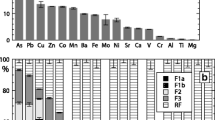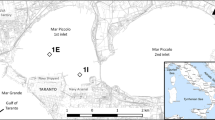Abstract
The sediments of the Tagus estuary North Channel arecharacterised by high concentrations of trace metals andmonosulphides. During dredging operations Cd, Cu and Pb wereanalysed in water and suspended sediments collected 50 to 100 m around the dredging point. Concentrations in bothfractions fluctuated randomly: 2–3 fold for Cd and Cu and 10 for Pb. Since sampling in the dredging point reflectsintegration of rapid chemical reactions, a short-termlaboratory experiment was conducted to follow the geochemicalalterations occurring in the highest turbidity sites. Theexperiment was monitored as a function of time over a period of4 hr in short time intervals. Dissolved oxygen, pH, EH,AVS, SO4 2-, Cl- and metals were monitored in theslurry samples. Iron, Mn, Cd, Pb and Cu were determined in thedissolved fraction (<0.45 μm), in the reactive solid phaseand in the total fraction. Resuspension resulted in asignificant release of Fe, Mn, Cd, Cu and Pb from the solids.Following the release Pb and Cu were almost totally scavengedin the 4 hr by the newly precipitated Fe oxyhydroxides, while more than 50% of the mobilised Cd remained in the dissolved fraction. The less efficient removal of Cd from solution implies a prolonged availability of this metal in the environment.
Similar content being viewed by others
References
Allen, H., Fu, G. and Deng, B.: 1993, 'Analysis of acid-volatile sulfide (AVS) and simultaneously extracted metals (SEM) for the estimation of potential toxicity in aquatic sediments', Environ. Toxicol. Chem. 12, 1441–1453.
APHA: 1975, Standard Methods for the Examination of Water and Wastewater, American Public Health Association, Washington, 1193 pp.
Arakaki, T. and Morse, J.: 1993, 'Coprecipitation and adsorption of Mn(II) with mackinawite (FeS) under conditions similar to those found in anoxic sediments', Geochim. Cosmochim. Acta 57, 9–14.
Balistrieri, L. and Murray, J.: 1986, 'The surface chemistry of sediments from the Panama basin: The influence of Mn oxides on metal adsorption', Geochim. Cosmochim. Acta 50, 2235–2243.
Basolo, F. and Pearson, R.: 1967, Mechanisms of Inorganic Reactions: A Study of Metal Complexes in Solution, John Wiley & Sons, New York.
Benjamin, M. and Leckie, J.: 1981, 'Multiple-site adsorption of Cd, Cu, Zn and Pb on amorphous iron oxyhydroxide', J. Coll. Interf. Sci. 79, 209–221.
Calmano, W., Forstner, U. and Hong, J.: 1994, 'Mobilization and Scavenging of Heavy Metals Following Resuspension of Anoxic Sediments from the Elbe River', in C. Alpers and D. Blowes (eds), Environmental Geochemistry of Sulfide Oxidation, American Chemical Society, pp. 298–321.
Canário, J.: 2000, 'Mercú rio em sedimentos contaminados e águas intersticiais da cala norte do estuário do Tejo', Master Thesis, University Nova Lisboa-FCT, 98 pp.
Christl, I. and Kretzschmar, R.: 1999, 'Competitive sorption of copper and lead at the oxide-water interface: Implications for surface site density', Geochim. Cosmochim. Acta 63, 2929–2938.
Cooper, D. and Morse, J.: 1998, 'Extrability of metal sulfide minerals in acidic solutions: Application to environmental studies of trace metal contamination within anoxic sediments', Environ. Sci. Technol. 32 1076–1078.
Cooper, D. and Morse, J.: 1999, 'Selective extraction chemistry of toxic metal sulfides from sediments', Aquatic Geochem. 5 87–97.
Danielsson, L., Magnusson, B. and Westerlund S.: 1978, 'An improved metal extraction procedure for the determination of trace metals in sea water by atomic absorption spectrometry with electrothermal atomization', Anal. Chim. Acta 98, 47–57.
Davison, W. and Seed, G.: 1983, 'The kinetics of the oxidation of ferrous iron in synthetic and natural waters', Geochim. Cosmochim. Acta 47, 67–80.
Delaune, R. and Smith, C.: 1985, 'Release of nutrients and metals following oxidation of freshwater and saline sediment', J. Environ. Qual. 14, 164–168.
Di Toro, D., Mahony, J., Hansen, D., Scott, K., Hicks, M., Mayr, S. and Redmond, M.: 1990, 'Toxicity of cadmium in sediments: The role of acid volatile sulfide', Environ. Toxicol. Chem. 9, 1487–1502.
Ferreira, A., Micaelo, C. and Vale, C.: 1998, 'Nova travessia rodoviária sobre o tejo em Lisboa. Monitorizaç ã o da qualidade da água', IPIMAR, Technical Report VI, Lusoponte.
Gerringa, L.: 1995, 'Speciation of Trace Metals in Relation to Degradation of Organic Matter in Marine Sediment Slurries', Ph.D. Thesis, Rijksuniversiteit Groningen, 90 pp.
Goto, K., Komatsu, T. and Furukawa, T.: 1962, 'Rapid colorometric determination of manganese in waters containing iron - A modification of the formaldoxime method', Anal. Chim. Acta 27, 331–334.
Henneke, E., Luther, G. and De Lange, G.: 1991, 'Determination of inorganic sulphur speciation with polarographic techniques: Some preliminary results from recent hypersaline anoxic sediments', Mar. Geol. 100, 115–123.
Hirst, J. and Aston, S.: 1983, 'Behaviour of copper, zinc, iron and manganese during experimental resuspension and reoxidation of polluted anoxic sediments', Estuar. Coast. Shelf. Sci. 16, 549–558.
Huerta-Diaz, M. and Morse, J.: 1990, 'A quantitative method for determination of trace metal concentrations in sedimentary pyrite', Mar. Chem. 29, 119–144.
Huerta-Diaz, M., Tessier, A. and Carignan, R.: 1998, 'Geochemistry of trace metals associated with reduced sulfur in freshwater sediments', Appl. Geochem. 13, 212–233.
Luther, G.: 1987, 'Pyrite oxidation and reduction: Molecular orbital theory considerations', Geochim. Cosmochim. Acta 51, 3193–199.
Temporal and spatial variability of reduced sulfur species (FeS, S2O 2-3 ) and porewater parameters in salt marsh sediments', Biogeochem. 14, 57–88.
Luther, G. and Tsamakis, E.: 1989, 'Concentration and form of dissolved sulfide in the oxic water column of the ocean', Mar. Chem. 27, 165–177.
Morse, J.: 1991, 'Oxidation kinetics of sedimentary pyrite seawater', Geochim. Cosmochim. Acta 55, 3665–3667.
Morse, J.: 1994, 'Interaction of trace metals with authigenic sulfide minerals: Implications for their bioavalability' Mar. Chem. 46, 1–6.
Moses, C., Nordstrom, D., Herman, J. and Mills, A.: 1987, 'Aqueous pyrite oxidation by dissolved oxygen and by ferric iron', Geochim. Cosmochim. Acta 51, 1561–1571.
Petersen, W., Hong, J., Willamowski, C. and Wallmann, K.: 1996, 'Release of trace contaminants during reoxidation of anoxic sediment slurries in oxic water', Archives Hydrobiology Special Issues Advanced Limnology 47, 295–305.
Petersen, W., Willer, E. and Willamowski, C.: 1997, 'Remobilisation of trace elements from polluted anoxic sediments after resuspension in oxic water', Water, Air, and Soil Pollut. 99, 515–522.
Rantala, R. and Loring, D.: 1977, 'A rapid determination of 10 elements in marine suspended particulate matter by atomic absorption', At. Absorp. Newsl. 16, 51–52.
Saulnier, I. and Mucci, A.: 2000, 'Trace metal remobilisation following the resuspension of estuarine sediments: Saguenay Fjord, Canada', Appl. Geochem. 15, 203–222.
Schoonen, M. and Barnes, H.: 1991, 'Reactions forming pyrite and marcasite from solution. II. Via FeS percusor below 100 º C', Geochim. Cosmochim. Acta 55, 1505–1514.
Shaw, T., Gieskes, J. and Jahnke, R.: 1990, 'Early diagenesis in different depositional environments: The response of transition metals in pore water', Geochim. Cosmochim. Acta 54, 1233–1246.
Simpson, S., Apte, S. and Batley, G.: 1998, 'Effect of short-term resuspension events on trace metal speciation in polluted anoxic sediments', Environ. Sci. Technol. 32, 620–625.
Simpson, S., Apte, S. and Batley, G.: 2000, 'Effect of short-term resuspension events on the oxidation of cadmium, lead, and zinc sulfide phases in anoxic estuarine sediments', Environ. Sci. Technol. 34, 4533–4537.
Stookey, L.: 1970, 'Ferrozine - A new spectrofotometric reagent for iron', Anal. Chem. 42, 778–781.
Stumm, W. and Morgan, J.: 1996, Aquatic Chemistry. Chemical Equilibria and Rates in Natural Waters', Wiley-Interscience, New York, 1022 pp.
Tack, F., Lapauw, F. and Verloo, M.: 1997, 'Determination and fractionation of sulphur in a contaminated dredged sediment', Talanta 44, 2185–2192.
Thamdrup, B., Glud, R. and Hansen, J.: 1994, 'Manganese oxidation and in situ manganese fluxes from a coastal sediment', Geochim. Cosmochim. Acta 58, 2563–2570.
Vale, C.: 1986, 'FrDistribuiç ã o de metais e matéria particulada em suspensã o no sistema estuarino do Tejo', Research Dissertation, National Research Institute for Fisheries, 183 pp.
Vale, C.: 1990, 'Temporal variations of particulate metals in the Tagus River Estuary', Sci. Tot. Environ. 97/98, 137–154.
Vale, C., Ferreira, A., Micaelo, C., Caetano, M., Pereira, E., Madureira, M. and Ramalhosa, E.: 1998, 'Mobility of contaminants in relation to dredging operations in a mesotidal estuary (Tagus estuary, Portugal)', Wat. Sci. Techn. 37, 25–31.
Zhang, J. and Millero, F.: 1993, 'The products from the oxidation of H2S in seawater', Geochim. Cosmochim. Acta 57, 1705–1718.
Zhuang, Y, Allen, H. and Fu, G.: 1994, 'Effect of aeration of sediment on cadmium binding', Environ. Toxicol. Chem. 13, 717–724.
Author information
Authors and Affiliations
Corresponding author
Rights and permissions
About this article
Cite this article
Caetano, M., Madureira, MJ. & Vale, C. Metal Remobilisation during Resuspension of Anoxic Contaminated Sediment: Short-Term Laboratory Study. Water, Air, & Soil Pollution 143, 23–40 (2003). https://doi.org/10.1023/A:1022877120813
Issue Date:
DOI: https://doi.org/10.1023/A:1022877120813




